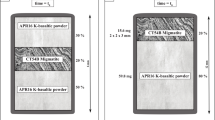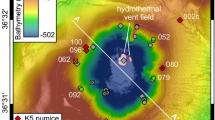Abstract
The south flank of Kilauea Volcano is unstable and has the structure of a huge landslide; it is one of at least 17 enormous catastrophic landslides shed from the Hawaiian Islands. Mechanisms previously proposed for movement of the south flank invoke slip of the volcanic pile over seafloor sediments. Slip on a low friction décollement alone cannot explain why the thickest and widest sector of the flank moves more rapidly than the rest, or why this section contains a 300 km3 aseismic volume above the seismically defined décollement. It is proposed that this aseismic volume, adjacent to the caldera in the direction of flank slip, consists of olivine cumulates that creep outward, pushing the south flank seawards. Average primary Kilauea tholeiitic magma contains about 16.5 wt.% MgO compared with an average 10 wt.% MgO for erupted subaerial and submarine basalts. This difference requires fractionation of 17 wt.% (14 vol.%) olivine phenocrysts that accumulate near the base of the magma reservoir where they form cumulates. Submarine-erupted Kilauea lavas contain abundant deformed olivine xenocrysts derived from these cumulates. Deformed dunite formed during the tholeiitic shield stage is also erupted as xenoliths in subsequent alkalic lavas. The deformation structures in olivine xenocrysts suggest that the cumulus olivine was densely packed, probably with as little as 5–10 vol.% intercumulus liquid, before entrainment of the xenocrysts. The olivine cumulates were at magmatic temperatures (>1100°C) when the xenocrysts were entrained. Olivine at 1100°C has a rheology similar to ice, and the olivine cumulates should flow down and away from the summit of the volcano. Flow of the olivine cumulates places constant pressure on the unbuttressed seaward flank, leading to an extensional region that localizes deep intrusions behind the flank; these intrusions add to the seaward push. This mechanism ties the source of gravitational instability to the caldera complex and deep rift systems and, therefore, limits catastrophic sector failure of Hawaiian volcanoes to their active growth phase, when the core of olivine cumulates is still hot enough to flow.
Similar content being viewed by others
References
Albarede F, Tamagnan V (1988) Modelling the recent geochemical evolution of the Piton de la Fournaise Volcano, Reunion Island, 1931–1986. J Petrol 29:997–1030
Atwill TM, Garcia MO (1985) Petrogenesis of ultramafic xenoliths from Mauna Kea: mantle or crust origin? Trans Am Geophys Union 66:1133
Basaltic Volcanism Study Project (1981) Basaltic volcanism on the terrestrial planets. Pergamon Press, New York, pp 161–192
Bohrson WB, Clague DA (1988) Origin of ultramafic xenoliths containing exsolved pyroxenes from Hualalai Volcano, Hawaii. Contrib Mineral Petrol 100:139–155
Borgia A, Treves B (1992) Volcanic plates overriding the ocean crust: structure and dynamic of Hawaiian volcanoes. In: Parson LM, Murton BJ, Browning P (eds) Ophiolites and their oceanic analogies. Spec Publ Geol Soc Am 60:277–299
Bryan CJ (1993) A possible triggering mechanism for large Hawaiian earthquakes derived from analysis of the 26 June 1989 Kilauea south flank sequence. Bull Seismol Soc Am 82:2368–2390
Chen C-Y (1993) High-magnesium primary magmas from Haleakala Volcano, east Maui, Hawaii; petrography, nickel, and major-element constraints. J Volcanol Geotherm Res 55:143–153
Chen C-H, Presnall DC, Stern RJ (1992) Petrogenesis of ultramafic xenoliths from the 1800 Kaupulehu Flow, Hualalai Volcano, Hawaii. J Petrol 33:163–202
Chopra PN, Patterson MS (1981) The experimental deformation of olivine. Tectonophysics 78:453–473
Clague DA (1987) Hawaiian xenolith populations, magma supply rates, and development of magma chambers. Bull Volcanol 49:577–587
Clague DA (1988) Petrology of ultramafic xenoliths from Loihi Seamount, Hawaii. J Petrol 29:1161–1186
Clague DA, Bohrson WA (1991) Origin of xenoliths in the trachyte at Puu Waawaa, Hualalai Volcano, Hawaii. Contrib Mineral Petrol 108:439–452
Clague DA, Dalrymple, GB (1987) The Hawaiian-Emperor volcanic chain. Part 1. Geologic evolution. US Geol Surv Prof Pap 1350:5–54
Clague DA, Moore JG (1991) Geology and petrology of Mahukona Volcano, Hawaii. Bull Volcanol 53:159–172
Clague DA, Weber WS, Dixon JE (1991) Picritic glasses from Hawaii. Nature 353:553–556
Clague DA, Moore JG, Dixon JE, Friesen WB. The petrology of submarine lavas from Kilauea's Puna Ridge, Hawaii. J Petrol, in press
Delaney PT, Fiske RS, Miklius A, Okamura AT, Sako M (1990) Deep magma body beneath the summit and rift zones of Kilauea Volcano, Hawaii. Science 247:1311–1346
Delaney PT, Miklius A, Arnadottir T, Okamura AT, Sako MK (1993) Motion of Kilauea Volcano during sustained eruption from the Puu Oo and Kupaianaha vents, 1983–1991. J Geophys Res 98:17801–17820
Denlinger RP, Okubo P. Structure of the south flank of Kilauea Volcano, Hawaii. J Geophys Res, in press
Dieterich JH (1988) Growth and persistence of Hawaiian volcanic rift zones. J Geophys Res 93:4258–4270
Dvorak JJ, Okamura AT, English TT, Koyanagi RY, Nakata JS, Sako MK, Tanigawa WT, Yamashita KM (1986) Mechanical response of the south flank of Kilauea Volcano, Hawaii, to intrusive events along the rift systems. Tectonophysics 124:193–209
Dzurisin D, Koyanagi RY, English TT (1984) Magma supply and storage at Kilauea Volcano, Hawaii 1956–1983. J Volcanol Geotherm Res 7:241–270
Guest JE, Chester DK, Duncan AM (1984) The Valle del Bove, Mount Etna: its origin and relation to the stratigraphy and structure of the volcano. J Volcanol Geotherm Res 21:1–23
Helz RT (1987) Diverse olivine types in lava of the 1959 eruption of Kilauea Volcano, and their bearing on eruption dynamics. US Geol Surv Prof Pap 1350:691–722
Helz RT, Thornber CR (1987) Geothermometry of Kilauea Iki lava lake, Kilauea Volcano, Hawaii. Bull Volcanol 49:651–668
Henstock TJ, Woods AW, White RS (1993) The accretion of oceanic crust by episodic sill intrusion. J Geophys Res 98:4143–4161
Hill DP, Zucca JJ (1987) Geophysical constraints on the structure of Kilauea and Mauna Loa Volcanoes and some implications for seismotectonic processes. US Geol Surv Prof Pap 1350:903–918
Holcomb RT, Searle RC (1991) Large landslides from oceanic volcanoes. Mar Geotechnol 10:19–32
Irvine TN (1974) Petrology of the Duke Island Ultramafic Complex, southeastern Alaska. Mem Geol Soc Am 138: 240 pp
Iverson RM (1992) Rigid-wedge models for metastable flanks of Hawaiian volcanoes. Trans Am Geophys Union 73:505
Iverson RM Can magma-injection and groundwater forces cause massive landslides on Hawaiian volcanoes? J Volcanol Geotherm Res, in press
Jackson ED (1968) The character of the lower crust and upper mantle beneath the Hawaiian Islands. 23rd Int Geol Congress, Prague, Proc 1:135–150
Jackson ED, Wright TL (1970) Xenoliths in the Honolulu Volcanic Series, Hawaii. J Petrol 11:405–430
Kinoshita WT, Krivoy HL, Mabey DR, MacDonald RR (1963) Gravity survey of the island of Hawaii. US Geol Surv Prof Pap 475-C:C114-C116
Kirby SH, Green HW III (1980) Dunite xenoliths from Hualalai Volcano: evidence for mantle diapiric flow beneath the island of Hawaii. Am J Sci 280-A:550–575
Kirby SH, Kronenberg AK (1987) Rheology of the lithosphere: selected topics. Rev Geophys 25:1219–1244
Lama RD, Vutukuri VS (1978) Handbook on mechanical propertics of rocks. Vol. 2. Trans Tech, Clausthal, pp 1–481
Last NC (1988) Deformation of a sedimentary overburden on a slowly creeping substratum. In: Swoboda G (ed) Numerical Methods in Geomechanics. pp 577–575
Lehner FK (1977) A theory of substratal creep under varying overburden with applications to tectonics. Trans Am Geophys Union 58:508
Lénat J-F, Vincent P, Bachèlery P (1989) The off-shore continuation of an active basaltic volcano: Piton de la Fournaise (Réunion Island, Indian Ocean): structural and geomorphical interpretation from Sea Beam mapping. J Volcanol Geotherm Res 36:1–36
Lipman PW, Lockwood JP, Okamura RT, Swanson DA, Yamashita KM (1985) Ground deformation associated with the 1975 magnitude-7.2 earthquake and resulting changes in activity of Kilauea Volcano, Hawaii. US Geol Surv Prof Pap 1276:45 pp
Maaloe S, Hansen B (1982) Olivine phenocrysts of Hawaiian olivine tholeiite and oceanite. Contrib Mineral Petrol 81:203–211
Maaloe S, Tumyr O, James D (1989) Population density and zoning of olivine phenocrysts in tholeiites from Kauai, Hawaii. Contrib Mineral Petrol 101:176–186
McGeary RK (1961) Mechanical packing of sperical particles. J Am Ceram Soc 44:513–522
Mercier J-CC, Nicholas A (1975) Textures and fabrics of upper mantle peridotites as illustrated by xenoliths from basalts. J Petrol 16:454–487
Moore JG (1965) Petrology of deep-sea basalt near Hawaii. Am J Sci 263:40–52
Moore JG, Clague DA (1992) Volcano growth and evolution of the island of Hawaii. Geol Soc Am Bull 104:1471–1484
Moore JG, Mark RK (1992) Morphology of the Island of Hawaii. GSA Today 2:257–262
Moore JG, Clague DA, Holcomb RT, Lipman PW, Normark WR, Torresan MT (1989) Prodigious submarine landslides on the Hawaiian Ridge. J Geophys Res 94:17465–17484
Moore JG, Clague DA, Ludwig KR, Mark RK (1990) Subsidence and volcanism of the Haleakala Ridge, Hawaii. J Volcanol Geotherm Res 42:273–284
Murata KJ, Richter DH (1966) The settling of olivine in Kilauea magma as shown by lavas of the 1959 eruption. Am J Sci 264:194–203
Nakamura K (1980) Why do long rift zones develop in Hawaiian volcanoes — a possible role of thick oceanic sediments. Bull Volcanol Soc Jpn 25:255–269
Nicholls J, Stout MZ (1988) Picritic melts in Kilauea — evidence from the 1967–1968 Halemaumau and Hiiaka eruptions. J Petrol 29:1031–1057
Phipps-Morgan J, Chen YJ (1993) The genesis of ocean crust: magma injection, hydrothennal injection, and crustal flow. J Geophys Res 98:6283–6297
Pike JEN, Schwarzmann EC (1977) Classification of textures in ultramafic xenoliths. J Geol 85:49–61
Quick JE, Denlinger RP (1993) Ductile deformation and the origin of layered gabbro in ophiolites. J Geophys Res 98:14015–14029
Rançon JP, Lerebour P, Augé T (1989) The Gran Brûlé exploration drilling: new data on the deep framework of the Piton de la Fournaise volcano. Part 1. Lithostratigraphic units and volcanostructural implications. J Volcanol Geotherm Res 36:113–128
Rousset D, Lesquer A, Bonneville A, Lénat J-F (1989) Complete gravity study of Piton de la Fournaise Volcano, Réunion Island. J Volcanol Geotherm Res 36:37–52
Ryan MP (1988) The mechanics and three-dimensional internal structure of active magma systems: Kilauea Volcano, Hawaii. J Geophys Res 93:4213–4248
Savage WZ, Swolfs HS, Amedei B (1992) On the state of stress in the near-surface of the Earth's crust. Pure Appl Geophys 138:207–228
Schwindinger K, Anderson AT Jr (1989) Synneusis of Kilauea Iki olivines. Contrib Mineral Petrol 103:187–198
Sen G, Presnall DC (1980) Dunite nodules from the Koolau shield, Hawaii: crystal cumulates from a tholeiitic magma chamber. Geol Soc Am Abstr Prog 12:519
Sen G, Presnall DC (1986) Petrogenesis of dunite xenoliths from Koolau Volcano, Oahu, Hawaii: implications for Hawaiian volcanism. J Petrol 27:197–217
Shaw HR (1972) Viscosities of magmatic silicate liquids: an empirical method of prediction. Am J Sci 272:870–893
Stearns HT, Macdonald GA (1946) Geology and ground-water resources of the island of Hawaii. Hawaii Div Hydrogr Bull 9:363 pp
Stormer JC Jr (1973) Calcium zoning in olivine and its relationship to silica activity and pressure. Geochim Cosmochim Acta 27:1815–1821
Swanson DA, Duffield WA, Fiske RS (1976) Displacement of the south flank of Kilauea Volcano, Hawaii: the result of forceful intrusion of magma into rift zones. US Geol Surv Prof Pap 963:1–39
Takahashi E (1980) Thermal history of lherzolite xenoliths — 1. Petrology qf lherzolite xenoliths from the Ichinomegata crater, Oga peninsula, northeast Japan. Geochim Cosmochim Acta 44:1643–1658
Upton BGJ, Wadsworth WJ (1972) Peridotitic and gabbroic rocks associated with the shieldforming lavas of Reunion. Contrib Mineral Petrol 35:139–158
White RW (1966) Ultramafic inclusions in basaltic rocks of Hawaii. Contrib Mineral Petrol 12:245–314
Wikinson JFG, Hensel HD (1988) The petrology of some picrites from Mauna Loa and Kilauea volcanoes, Hawaii. Contrib Mineral Petrol 98:326–345
Wright TL (1971) Chemistry of Kilauea and Mauna Loa in space and time. US Geol Surv Prof Pap 735:40
Author information
Authors and Affiliations
Corresponding author
Rights and permissions
About this article
Cite this article
Clague, D.A., Denlinger, R.P. Role of olivine cumulates in destabilizing the flanks of Hawaiian volcanoes. Bull Volcanol 56, 425–434 (1994). https://doi.org/10.1007/BF00302824
Received:
Accepted:
Issue Date:
DOI: https://doi.org/10.1007/BF00302824




